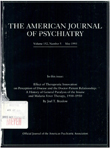Intergenerational transmission of child abuse: rates, research, and clinical implications
Abstract
OBJECTIVE: The author reviews current wisdom concerning the rates and mechanisms of intrafamilial components of intergenerational transmission of child abuse and illustrates the unreliability of basic data and of assumptions made by reviewers and partisan advocates, most of whom underestimate the importance of intrafamilial factors in child abuse. METHOD: The information in the report was derived from original research plus a recently prepared compilation of 60 studies, mainly from the United States and the United Kingdom. RESULTS: The crude rates of intergenerational transmission of child abuse according to the studies reviewed are as follows: one-third of child victims grow up to continue a pattern of seriously inept, neglectful, or abusive rearing as parents. One-third do not. The other one-third remain vulnerable to the effects of social stress on the likelihood of their becoming abusive parents. Intrafamilial factors appear to be the cause of personally directed, as opposed to culturally condoned, child abuse. Broad social factors, and some medical and psychiatric conditions, lower or raise thresholds in which family and personal vulnerabilities and propensities operate. CONCLUSIONS: There is no justification for any extremist advocacy in apportioning responsibility between the "sins of the parents" and the failings of society. The contention that clinical research on abuse is inferior to, and must give way to, large- scale or statistically balanced self-report and questionnaire surveys is plausible, popular, convincing, and wrong.
Access content
To read the fulltext, please use one of the options below to sign in or purchase access.- Personal login
- Institutional Login
- Sign in via OpenAthens
- Register for access
-
Please login/register if you wish to pair your device and check access availability.
Not a subscriber?
PsychiatryOnline subscription options offer access to the DSM-5 library, books, journals, CME, and patient resources. This all-in-one virtual library provides psychiatrists and mental health professionals with key resources for diagnosis, treatment, research, and professional development.
Need more help? PsychiatryOnline Customer Service may be reached by emailing [email protected] or by calling 800-368-5777 (in the U.S.) or 703-907-7322 (outside the U.S.).



